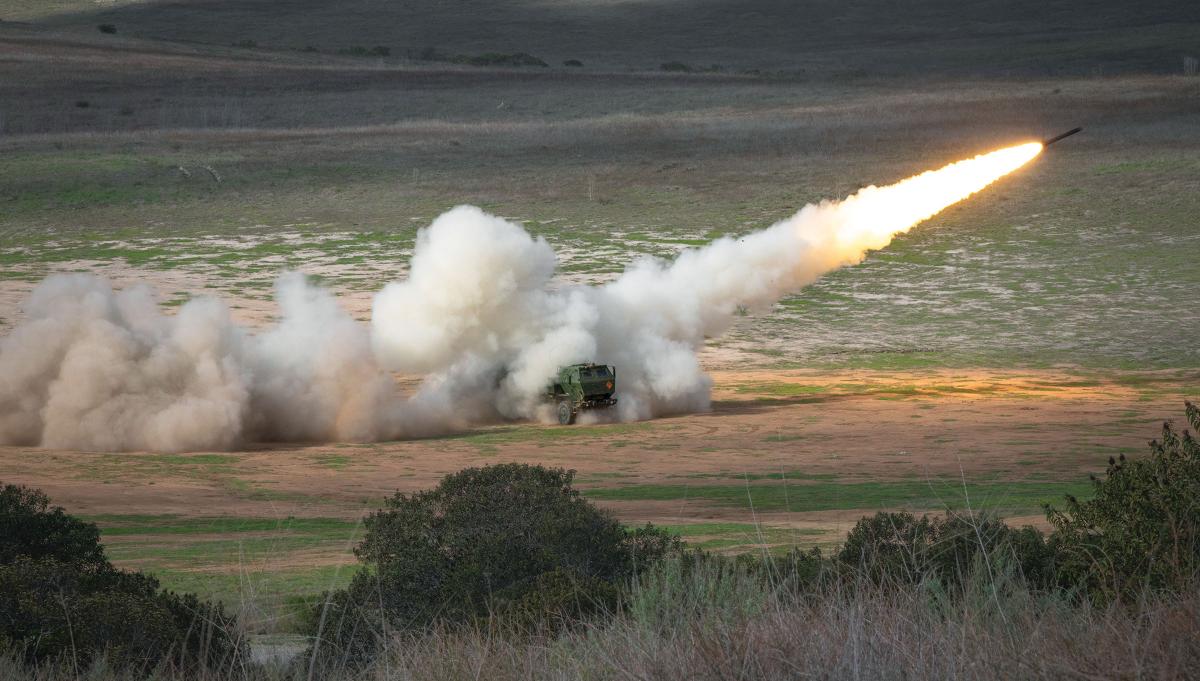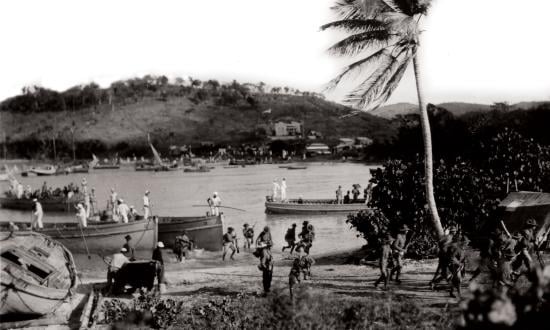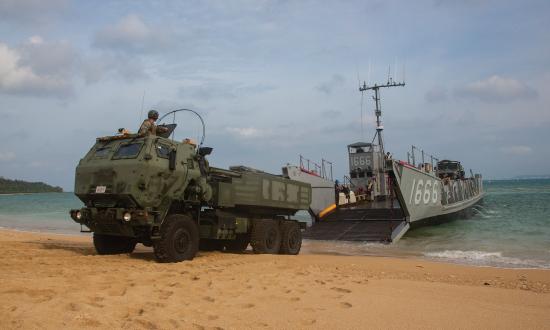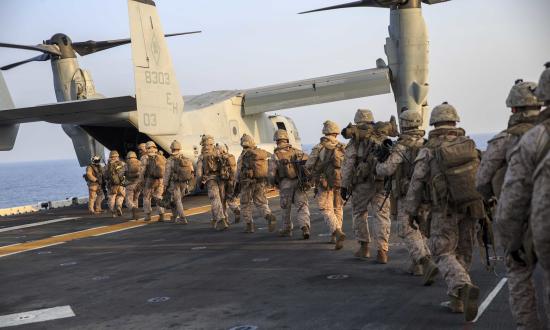One of the strengths of Marine Corps rocket artillery is proficiency at distributed operations. High Mobility Artillery Rocket System (HiMARS) batteries train for individual launchers to reposition from firing point to firing point independently for survivability. This capability was demonstrated to great effect in support of amphibious landings and sea-denial operations during Exercise Talisman Sabre 19 in Queensland, Australia.
In that exercise, missions were generated and approved at the two-star level from the supporting arms coordination center afloat or the force fires coordination center ashore. However, one of the core assumptions of the expeditionary advanced base operations (EABO) concept is that to generate “the virtues of mass without the vulnerabilities of concentration,” platforms must have low electromagnetic signatures and be horizontally dispersed.1 To maintain both dispersion and a minimal signature, long-range precision-fire units will need mission approval at a much lower level than the two- or three-star headquarters. A major or even a captain will command a fires EAB, and communication with higher headquarters could be episodic at best. How, therefore, will the EAB commander be able to clear and approve long-range precision-fire missions? At III Marine Expeditionary Force (III MEF) in Okinawa, Japan, planners have been working on an answer: the expeditionary fires–air control center.
Exercise Southern Reach
In August 2019, Marine Rotational Force–Darwin (MRF-D) 19.2 conducted Exercise Southern Reach in Bradshaw Field Training Area, Northern Territory, Australia. Southern Reach was first and foremost an opportunity for the rotational HiMARS battery to shoot III MEF’s yearly allotment of two guided multiple launch rocket systems
(GMLRS), something that cannot be done at any other training venue open to III MEF in its area of responsibility. Because the MRF-D command element did not have a fire support section, 3d Marine Division Fire Support Coordination Center (FSCC) traveled to Darwin in that capacity to conduct digital fire support coordination using the Advanced Field Artillery Tactical Data System (AFATDS).
The next problem to tackle was the MRF-D’s lack of organic intelligence, surveillance, and reconnaissance (ISR) and the need to have a sensor capable of detecting suitable targets. The solution was to use spaced-based national technical means to fill the ISR gap. Satellites are primarily strategic-level collection assets that have a wide area of view and variable dwell time. MRF-D planners coordinated with the National Reconnaissance Office (NRO) to secure its participation in the exercise. While the NRO had exercised the concept of cueing fire missions before, this would be the first time it would execute it with a shooter located outside the continental United States.
To control the airspace needed to clear rocket fires, MRF-D integrated elements of Marine Air Control Squadron 4 (MACS-4) with the TPS-80 Ground/Air Task–Oriented Radar (G/ATOR) into the exercise. When combined with MRF-D’s organic air-support element, the air-control detachment gave the command element a miniature tactical air operations center (TAOC) and direct air-support center (DASC) necessary to clear the airspace. The air controllers also had the ability to receive targeting data directly from the satellites to their Common Aviation Command and Control System (CAC2S) workstation.
For the exercise, the team decided to colocate the TAOC, DASC, and FSCC in one tent. Within the tent, the team was able to do everything required to approve a target, deconflict airspace, and send a fire mission to the HiMARS platoon’s fire-direction center (FDC). In the after-action review, leaders realized that the colocation of these elements, done primarily for practical reasons, was actually a valid technique for facilitating the rapid engagement of targets with HiMARS and worth further exploration.
The How and the Why
In Southern Reach, target data was fed into a CAC2S machine. A MACS Marine passed the data from CAC2S to the MACS detachment’s AFATDS machine. From there, the FSCC received it and began working up the mission. While it did, the TAOC and DASC cleared the airspace. The NRO liaison was able to access and provide amplifying details on the target, which were used to help the commander decide whether to approve a strike. Once the strike was approved, the FSCC sent the mission to the FDC. The entire process took a crew that had never worked together before no more than ten minutes, on average.
Concentrating these elements of fires and air control does, of course, incur risk. However, the benefits of increasing the reliability of internal communications and decreasing electromagnetic signatures outweigh the risk of compromise or attack. The digital systems within the tent were all connected by wire in a local area network, not communicating over high-frequency radio or advanced network wideband waveform. There were fewer opportunities for enemy or environmental interference to inhibit communication, while the total number of data-over-radio transmissions required to complete the mission was reduced from three to one. In a distributed configuration, three radio bursts would be required to get the target data from the CAC2S, through the DASC and FSCC, to the HiMARS FDC. In the EFACC configuration, only the FSCC and the FDC were linked by radio. In addition, unlike the large tent configurations that typically incorporate an FSCC and a DASC, the overall footprint of the EFACC was small enough to be effectively concealed. Alternatively, it could be set up in an existing structure (a “hard stand” solution) to blend into urban terrain.
Employment
The use of the word control in the EFACC title is deliberate. Joint Publication 1-02, Department of Defense Dictionary of Military and Associated Terms, defines control as “physical or psychological pressures exerted with the intent to assure that an agent or group will respond as directed.”2 By contrast, Marines usually associate fire support with coordination instead of control. However, with an EFACC, the expeditionary base fires commander is not only capable of positively controlling friendly aircraft and fire support agencies within his or her area of responsibility, but also required to do so. Marines are taught to value decentralized execution, but under the circumstances leading to the launch of land-based, long-range precision fires in support of a naval campaign, it will be critical that orders be precise and followed to the letter. There will be no room for team members to creatively interpret them.
The EFACC can function in one of two ways. First, as demonstrated with MRF-D during Exercise Southern Reach, it can “bolt on” to a task force headquarters without an organic means of controlling airspace or coordinating fire support. Second, an EFACC can operate alone to control long-range precision fires and aircraft in the littorals, where its small footprint and low signature will allow it to persist inside an adversary’s sensor range. Its ability to receive data from long-dwell-time theater and strategic sensors and use it to cue aircraft targeting pods allows the aircraft to spend less time in an adversary’s weapons engagement zone. Finally, when coupled with unmanned launchers, a fires EAB with an EFACC as its nerve center contains far fewer humans than any current doctrinal configuration, meeting General David H. Berger’s Commandant’s Planning Guidance requirements to be both lean and risk-worthy.3 In conflict, the EAB could attack targets based on detailed engagement criteria supplemented by daily intentions messages, instead of having missions approved at the MEF or fleet headquarters.
Validating and Improving the Concept
More experimentation is required to validate the EFACC concept. With only one HiMARS platoon and virtually no friendly aircraft, Exercise Southern Reach represented a crawl. Two things are necessary to advance to a walk. First, the EFACC should tie in multiple firing units conducting independent movement and ensure the air-control component has to deconflict multiple sections of friendly aircraft.
Second, the EFACC needs to be able to hand off the target to a limited-field-of -view, high-resolution observer. A conceptual problem with Southern Reach was the use of wide-area, low-resolution tools as sensors as well as observers; while they excel at the former, their accuracy in the latter role was not verified. Ideally, after a target is sensed, the EFACC would use the data to cue a more accurate sensor, such as the targeting pod on a fourth- or fifth-generation fighter, to get refined targeting information suitable for generating a fire mission. Therefore, future experimentation with the EFACC concept must also integrate tactical aviation.
1. Art Corbett, Expeditionary Advanced Base Operations Handbook: Considerations for Force Development and Employment (Quantico, VA: Marine Corps Warfighting Lab, 1 June 2018), 59.
2. Joint Publication 1-02, Department of Defense Dictionary of Military and Associated Terms (November 2010), 49.
3. GEN David H. Berger, USMC, Commandant’s Planning Guidance (July 2019), 4; and Michael Magyar, “The HIMARS UGV,” Marine Corps Gazette, February 2019, 23.






